
Table of contents
Table of contents
How to launch a product: All you need to know

Summary
Launching a new product can feel like navigating uncharted waters. And with 6 in 10 knowledge workers saying that silos and busywork stall momentum, it’s easy to see how product launches can lose steam before they even start.
But with the right strategy, you can turn your product launch into a resounding success. Let’s dive into the essentials of how to launch a new product and how you can make your next release a hit.
In this article, you will learn:
What a product launch is and why it’s crucial for long-term success
When to start preparing for a launch and how early planning pays off
A step-by-step framework for building and executing a launch strategy
How to validate ideas with market research before launch
Practical tips for building anticipation and running launch day smoothly
How to analyze results and improve future launches
Try Miro now
Join thousands of teams using Miro to do their best work yet.
Plan your product launch with Miro
Every product starts with a new product launch marketing plan. With Miro, you can map your product vision, align your team, and keep every step - from strategy to execution - in one shared space.
What is a product launch?
A product launch is how you introduce a new product or service to the market. It’s an orchestrated effort to spark interest, build demand, and set your product up for success.
Most launches happen in stages: prep work before the big day, the launch itself, and follow-up afterward. Together, these steps help you create buzz, drive early sales, learn from customer feedback, and claim your spot in the market.
What’s the Difference Between a Product Launch and a Product Release?
A product launch is the broader go-to-market strategy that encompasses planning, marketing, and customer engagement. It is about preparing the market, creating awareness, and ensuring the product makes a meaningful impact once it is available. A product release, on the other hand, is the technical act of making the product available to customers or users. While the two often overlap, the key distinction is that a launch is focused on market impact, positioning, and adoption, whereas a release is primarily concerned with the delivery and availability of the product itself. In short, a release answers the question “Is it ready?” while a launch answers “Will it succeed in the market?”
Why new product launches matter
A strong product launch is often the crucial difference between a product that thrives and one that disappears. With competition fierce and customer expectations high, your launch can make or break everything that follows.
Here are four reasons to treat product launches as a critical step in your product journey:
Risk is real: Around 30,000 new products launch each year, and most of them fail. A well-planned launch reduces that risk by aligning your team and clarifying your go-to-market approach.
Customer appetite is strong: Research shows that 34% of people look for new products once or twice a year, and 48% do so four times a year or more. A strong launch makes sure they find yours.
Preparation delivers outcomes: Lack of preparation is one of the most common reasons launches flop. A clear process, from ideation through post-launch review, gives your product the best chance of success.
It sets the market tone: Done well, it builds visibility, drives sales, and positions your brand as a leader. Done poorly, it wastes resources and stalls growth.
Try Miro now
Map out your product vision from discovery to delivery – all in one unique product roadmap tool.
When should you start preparing for a product launch?
It’s important to start planning for a product launch as soon as possible. Ideally, this is while the product is still being defined and developed so you can align all teams with the product vision and roadmap. Getting ahead of things early will also enable you to refine your launch plan with real details such as features, pricing, go-to-market channels, and timelines.
In most cases, a product launch should be prepared at least two to three months before launch. This means you have plenty of time to align your teams, messaging, and go-to-market strategies before the product goes live.
What teams should be involved in a product launch?
Successful product launches are never the result of a single team working in isolation. They require seamless coordination across product, marketing, sales, support, and leadership. Each team plays a critical role: product defines the vision and ensures the solution meets market needs, marketing builds anticipation and communicates value, sales prepares to convert interest into revenue, support handles customer inquiries and feedback, and leadership provides strategic guidance and alignment. When these functions collaborate effectively, every stage from ideation and development to launch day and post-launch follow-up runs smoothly, creating a unified experience for both the team and the customer. Cross-functional collaboration is not just beneficial; it is essential for turning a product launch into a measurable success.
How to launch a new product: Step-by-step guide
Launching a new product involves more than just a great idea. Here’s a quick step-by-step guide to help you and your team navigate the process. You can also explore Miro's template library with 115+ Product Management templates and find valuable frameworks to help you take the first steps.
Draft a new product launch strategy
Your strategy should include clear goals, a detailed timeline, and a comprehensive marketing plan. For example, when launching a new software product, you might set goals for user acquisition, engagement, and retention.
Clear goals: Define specific, measurable, achievable, relevant, and time-bound (SMART) goals. For instance, aim to acquire 10,000 users within the first three months, achieve a 20% engagement rate, and retain 50% of users after six months.
Detailed timeline: Create a timeline that outlines each phase of the launch, from ideation to post-launch review. Include key milestones, deadlines, and dependencies.
Comprehensive marketing plan: Develop a marketing plan that covers all aspects of promotion, including content marketing, social media, email campaigns, influencer partnerships, and paid advertising. Ensure that each tactic aligns with your overall goals and timeline.
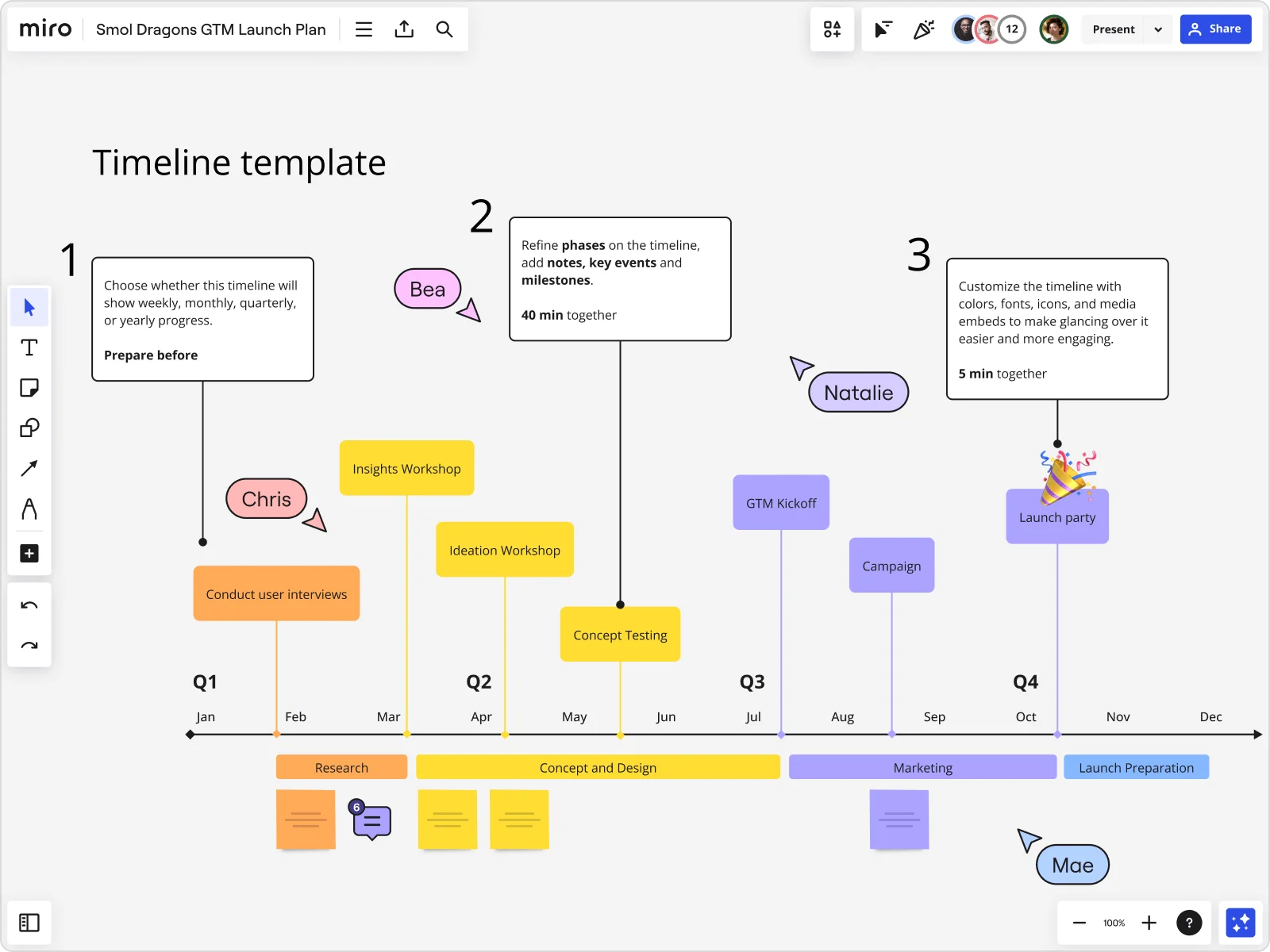
Ideation and concept development
Brainstorm and refine your product idea. Use Product Discovery session template to collaborate with your team in real-time or asynchronously. Check out how Mike Manalac, CPA at Walmart, goes through the Discovery to Delivery process with Miro:
Brainstorming sessions: Conduct brainstorming sessions with your team to generate a wide range of ideas. Use techniques like mind mapping, SWOT analysis, and the SCAMPER method to explore different angles.
Concept refinement: Narrow down the ideas to a few viable concepts. Evaluate each concept based on feasibility, market potential, and alignment with your company’s vision and goals.
Concept validation: Create a concept statement that outlines the product’s unique value proposition, target audience, and key features. Use this statement to gather initial feedback from stakeholders and potential customers.
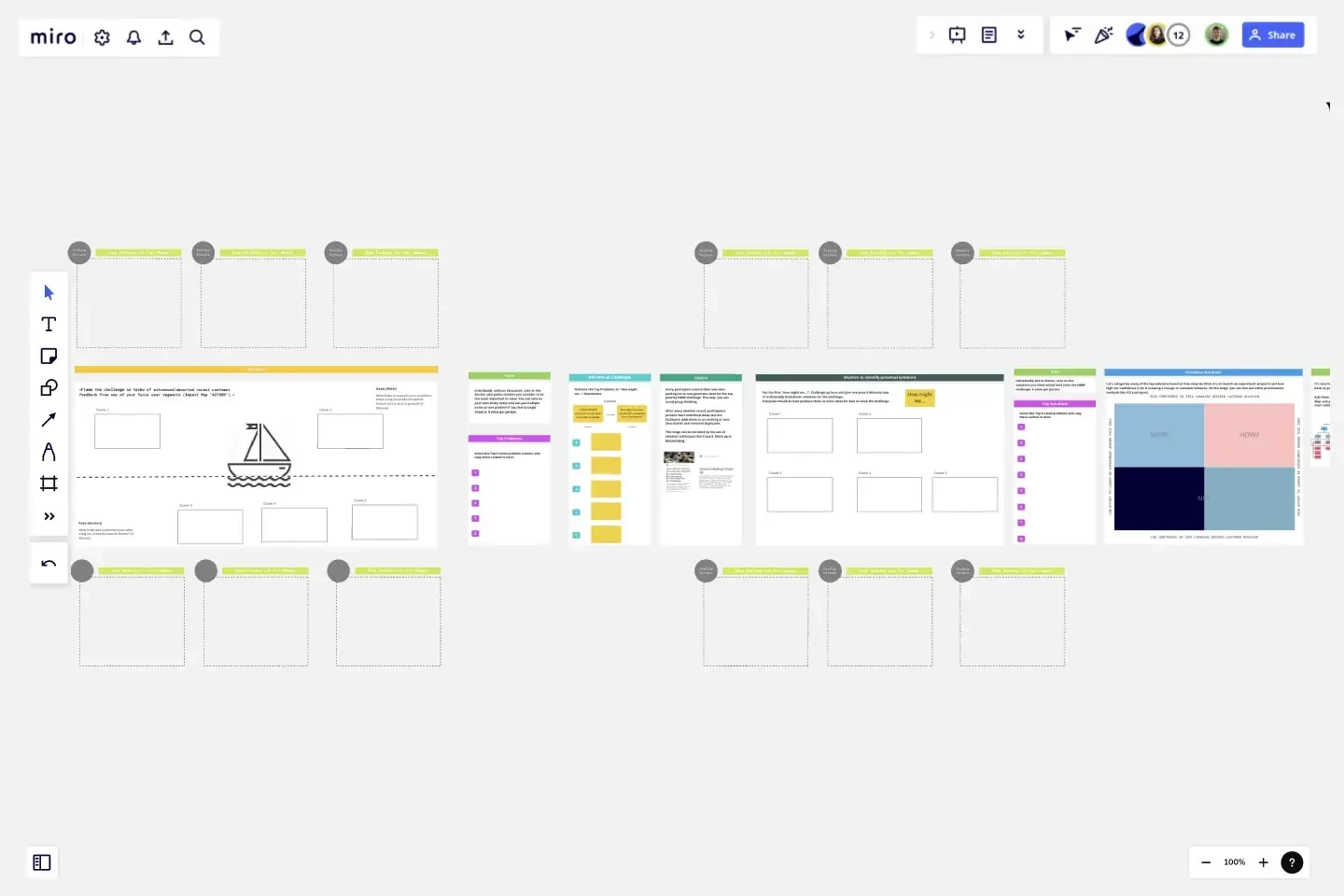
Market research
Validate your concept with market data. Conduct surveys, focus groups, and competitive analysis to understand the market landscape. Discover all market research templates available on our library.
Surveys: Design and distribute surveys to your target audience to gather quantitative data on their needs, preferences, and pain points. Use tools like Google Forms, SurveyMonkey, or Typeform.
Focus groups: Organize focus groups to gain qualitative insights. Engage participants in discussions about their experiences, expectations, and reactions to your product concept.
Competitive analysis: Analyze your competitors to understand their strengths, weaknesses, opportunities, and threats (SWOT). Identify gaps in the market that your product can fill and learn from competitors’ successes and failures.
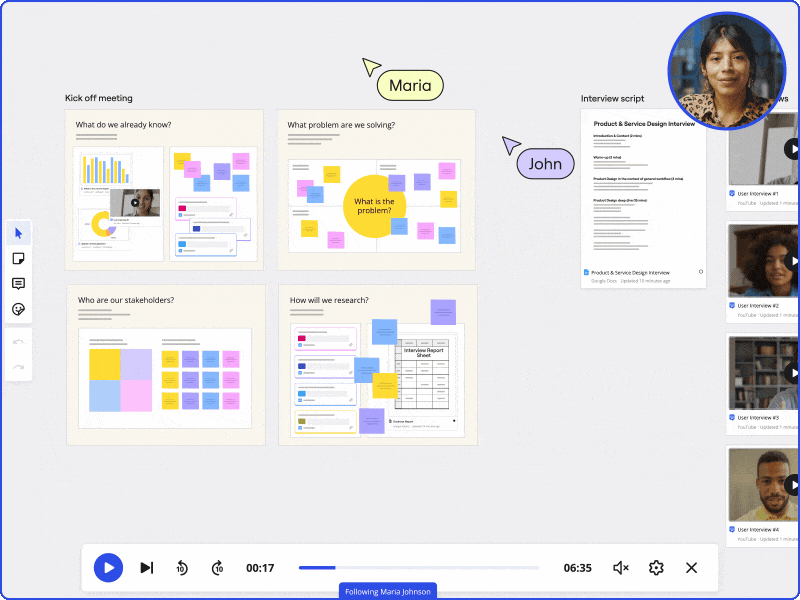
Product development
Design, prototype, and test your product. Use Agile methodologies to iterate quickly and incorporate feedback. Get some inspiration with Rosalba Giuffrida, Group Product Manager at Miro, and try Miro's prototyping tool leveraged by AI to speed your product development process:
Design: Create detailed design specifications, including wireframes, mockups, and user interface (UI) designs. Ensure that the design aligns with user needs and preferences identified during market research.
Prototyping: Develop a prototype to test the product’s functionality and usability.
Testing: Conduct usability testing with real users to identify any issues or areas for improvement. Use agile methodologies to iterate quickly, incorporating feedback and making necessary adjustments.
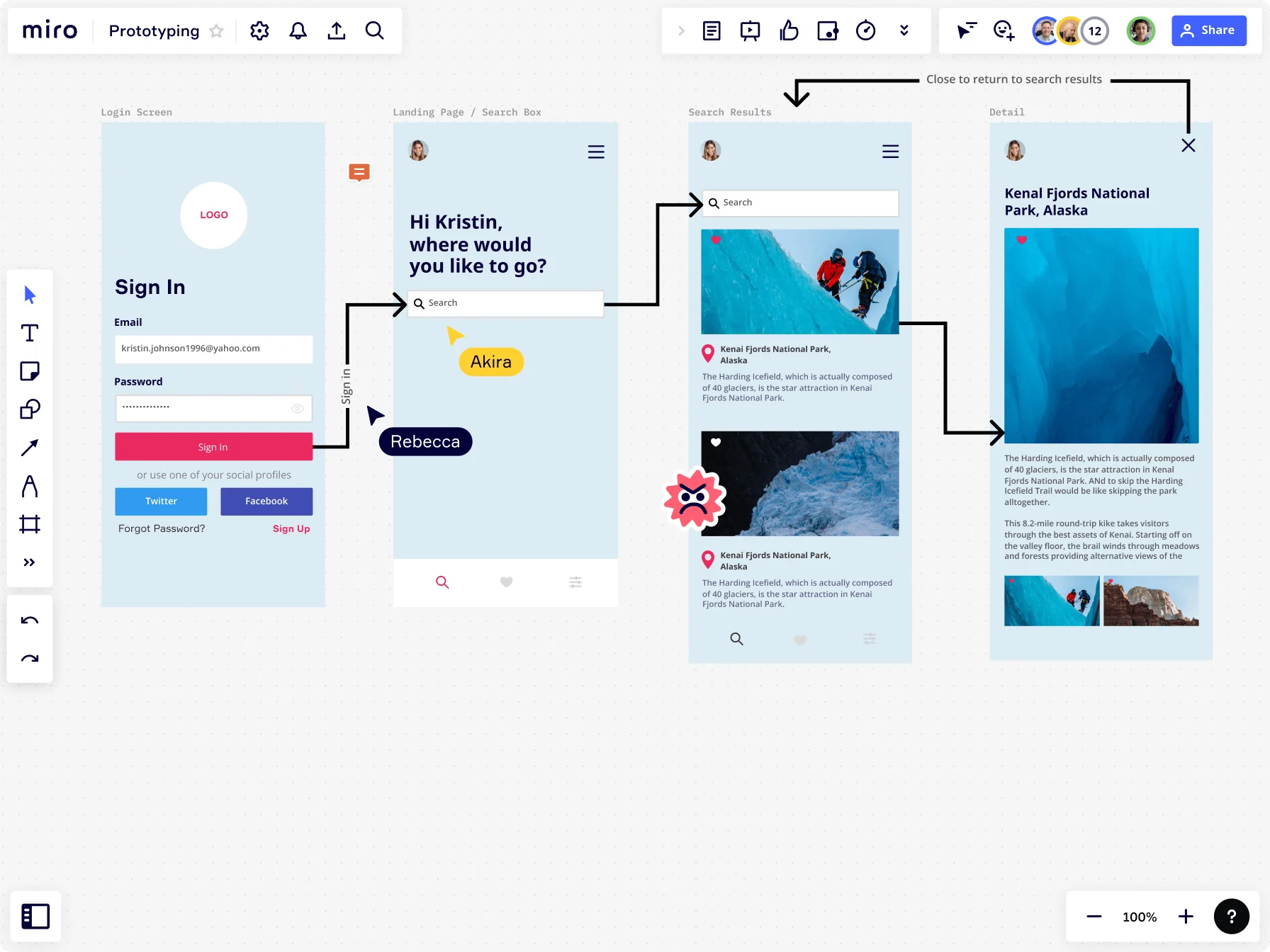
Marketing strategy
Plan your go-to-market strategy using Miro's GTM Plan template to organize visually your strategy. Define your target audience, messaging, and channels.
Target audience: Define your target audience segments based on demographics, psychographics, and behavior. Create detailed buyer personas to guide your marketing efforts.
Messaging: Develop key messages that communicate your product’s unique value proposition and benefits. Ensure that your messaging is consistent across all channels and resonates with your target audience.
Channels: Identify the most effective marketing channels to reach your target audience. This may include social media, email marketing, content marketing, search engine optimization (SEO), pay-per-click (PPC) advertising, and influencer partnerships.
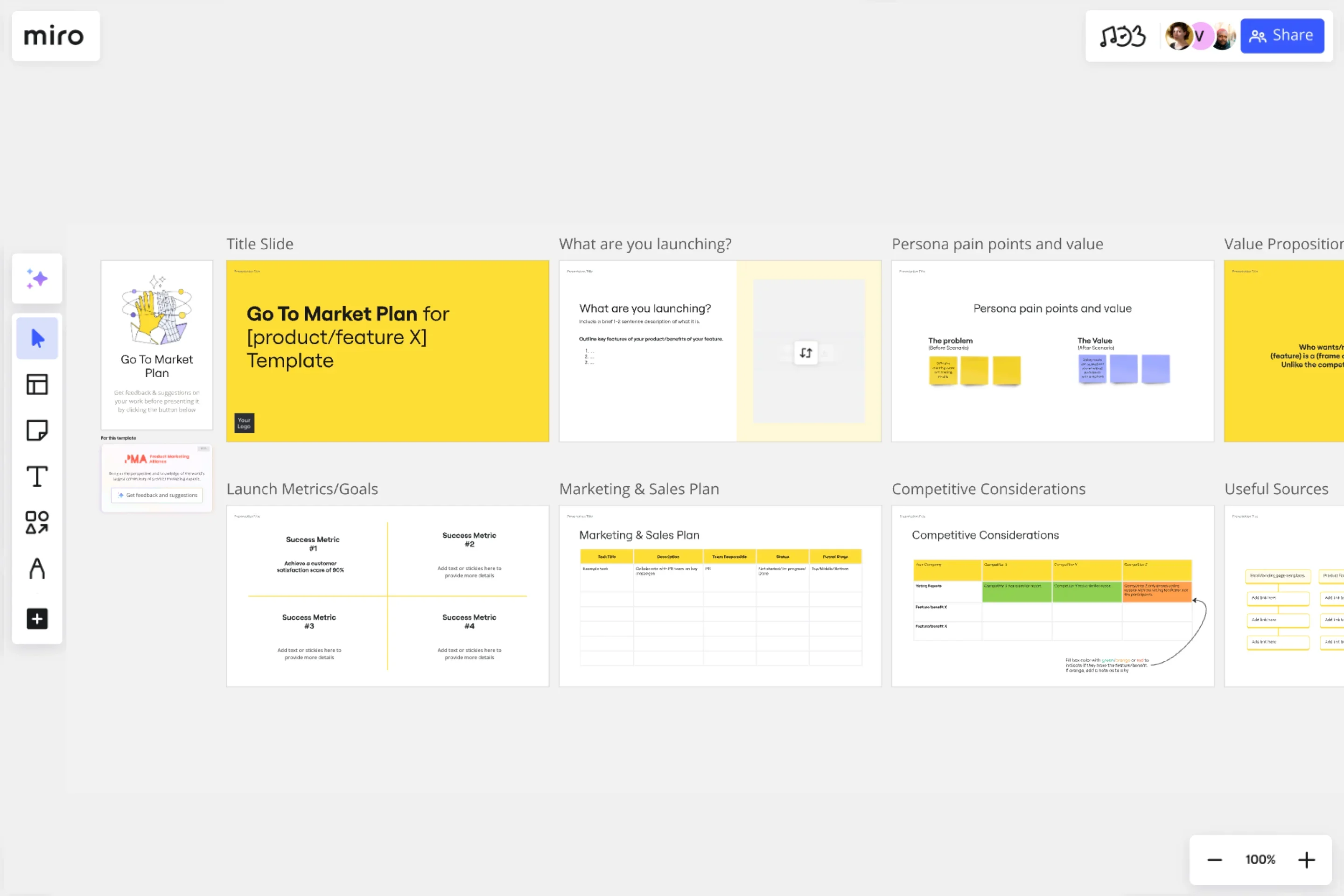
Launch execution
Roll out your product to the market. Coordinate with your team to ensure a seamless launch. Try the Product launch timeline template to help you organize and plan the launch of a new product from the start till the end.
Pre-launch activities: Build anticipation with teaser campaigns, pre-launch content, and early access offers. Ensure that all marketing materials, press releases, and launch events are ready.
Launch day: Execute your launch plan with precision. Monitor all channels for any issues and be prepared to address them quickly. Engage with your audience through live events, social media interactions, and customer support.
Post-launch support: Provide ongoing support to new users. Address any technical issues, answer questions, and gather feedback to improve the product.
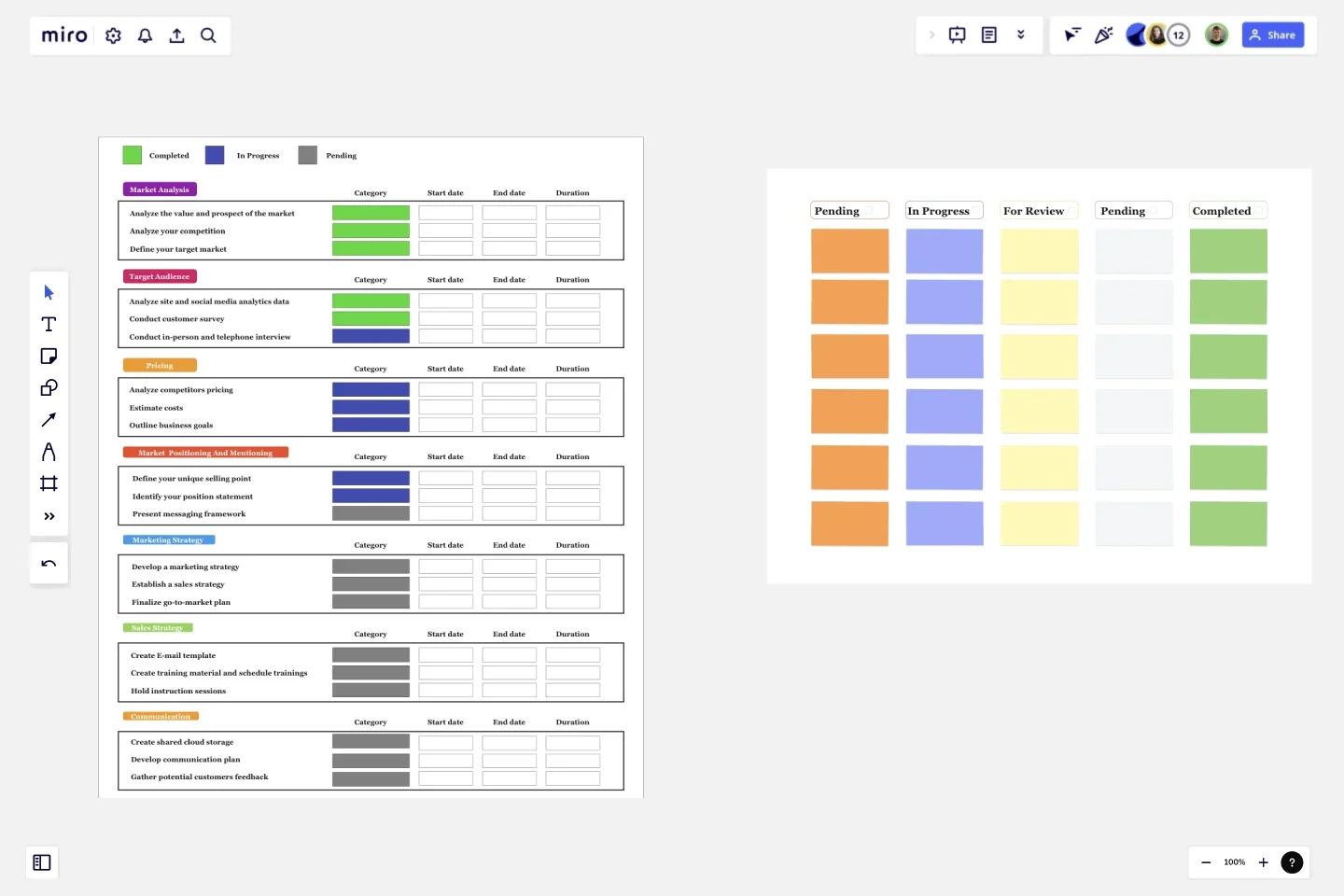
Post-Launch review
Analyze performance and gather feedback. Before moving forward to the next quarter, the product team should step back and reflect on their product. The reflection they make on their product will help establish a better sense of ownership and generate more ideas as they go.
Use Miro’s Product Reflection template to brainstorm on next steps.
Performance analysis: Review key performance indicators (KPIs) such as user acquisition, engagement, retention, and revenue. Compare these metrics against your initial goals to assess the success of the launch.
Customer feedback: Collect feedback from users through surveys, reviews, and direct interactions. Identify common themes and areas for improvement.
Team reflection: Conduct a retrospective with your team to discuss what went well, what didn’t, and what could be improved. Use these insights to refine your product and inform future launches.
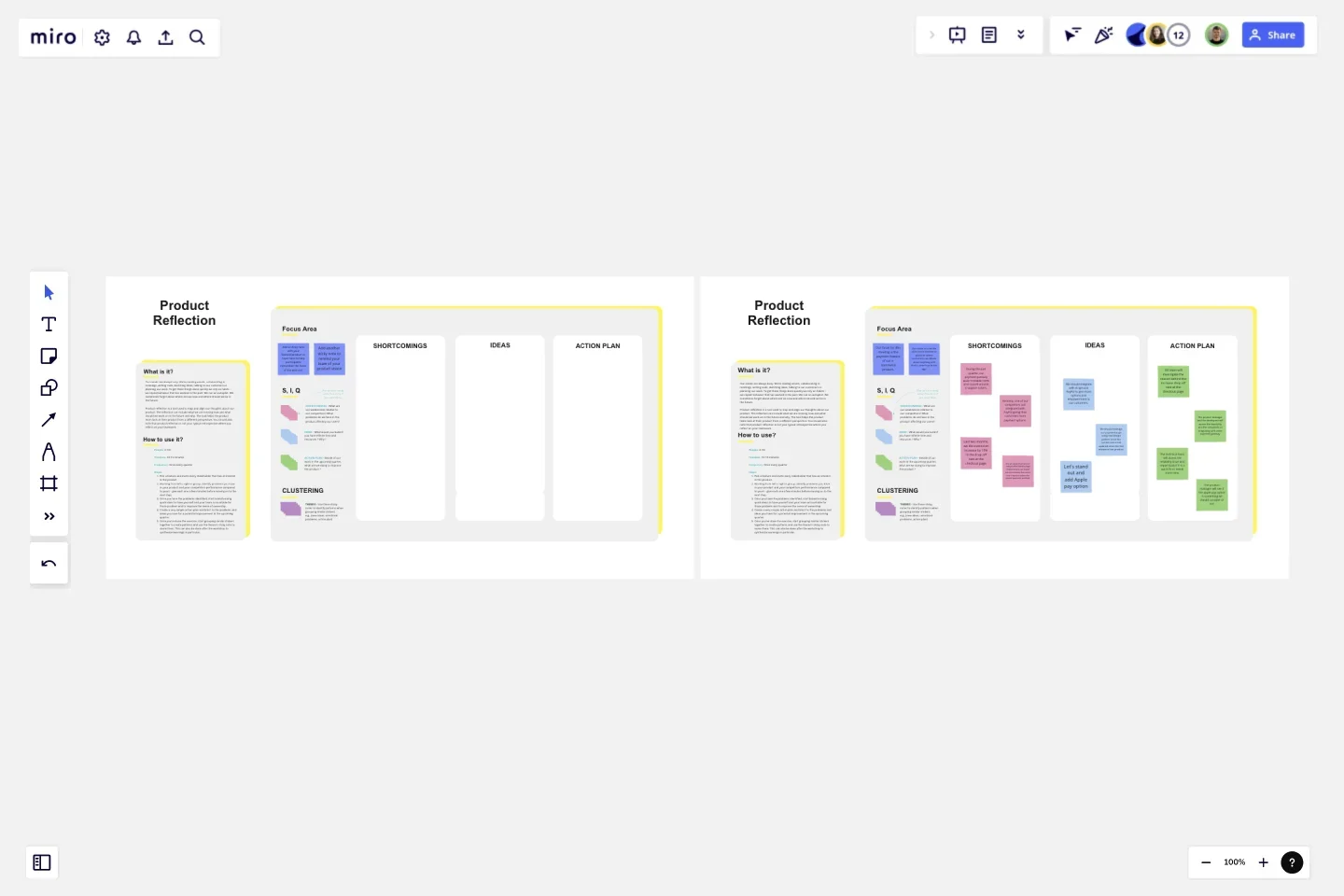
Product launch tips
Have a product launch checklist
A launch brings together strategy, design, marketing, sales, and customer support. But, without structure, it’s easy for details to slip through the cracks. A checklist helps you stay on top of every moving part, from pre-launch prep to post-launch follow-up. It keeps the whole team aligned, reduces risk, and makes sure nothing important gets missed.
Explore our full product launch checklist for a detailed breakdown of what to include.
Create a unique value proposition
Your product needs to stand out in a crowded market. Craft a compelling value proposition that clearly communicates the unique benefits of your product. Highlight what makes your product different and why customers should choose it over competitors.
For example, Slack’s value proposition focuses on simplifying team communication and increasing productivity, which resonated with its target audience.
Building anticipation: Pre-launch marketing tactics
Generating buzz before your launch can significantly impact its success. Use teasers, social media campaigns, and email marketing to build excitement. Engage with your audience and create a sense of anticipation. For example, Apple’s pre-launch events and teaser videos create immense hype and anticipation for their new product releases.
Effective launch day execution

Launch day is your moment to shine. Ensure everything runs smoothly by coordinating with your team, monitoring performance, and being ready to address any issues. Use live events, webinars, and social media to maximize visibility. For instance, when launching a new SaaS product, host a live demo to showcase its features and answer questions in real-time.
Post-launch analysis
After the launch, it’s essential to evaluate your performance. Track key metrics such as sales, customer feedback, and market penetration. Use this data to assess what worked, what didn’t, and how you can improve future launches.
For example, if your new product didn’t meet sales targets, analyze customer feedback to identify any areas for improvement.
Common challenges in new product launches
Launching a new product comes with its share of challenges. From technical glitches to market misalignment, being prepared for potential pitfalls can help you navigate them effectively. Ensure you learn from past experiences and stay adaptable.
For instance, when Google launched Google Glass, they faced significant privacy concerns and market resistance, which they had to address to improve future product iterations.
Case studies: successful new product launches
Looking at successful launches can provide valuable insights. For example, Apple’s iPhone launch revolutionized the smartphone market with its innovative features and sleek design.
Similarly, Slack’s strategic pre-launch marketing created a massive user base before the official release. These examples highlight the importance of innovation, marketing, and timing.
Ready to make your new product launch a success? Try Miro’s innovation workspace to collaborate seamlessly with your team, leveraging our AI-powered visual canvas to roadmap your product launch, execute, and track progress of your strategy.
Instapage speeds up product launches with Miro
Instapage’s launch process was slowed by messy communication, with scattered screenshots, long docs, and endless email threads across global teams. Delays piled up, making it harder to scale production and hit release deadlines.
With Miro, the team brought everything into one visual workspace. Stakeholders could @mention teammates, comment directly on designs, and organize feedback in one place. No more long email chains or late-night calls across time zones.
This led to:
20% faster design change decisions
Faster delivery of large-scale releases
Smoother collaboration across distributed teams
“I was spending too much time explaining ideas instead of improving them. Miro made the process faster and easier for everyone.”
Kevin Yang, Associate Product Manager
Start your journey with Miro today and turn your product launch into a triumph.
Product launch FAQs
How does Miro support product launches?
Miro provides a shared workspace where teams can map strategies, coordinate go-to-market plans, and track launch milestones. Real-time collaboration and templates keep everyone aligned from ideation through launch day.
Can I use Miro AI to speed up product launch planning?
Yes. Miro AI can cluster customer research, summarize campaign ideas, and generate launch checklists in minutes. This helps your team move faster from ideation to execution without losing time on manual prep.
How much does it cost to use Miro AI features?
Miro AI is available on all plans through a credit system. Each AI action uses one credit, with credits varying by plan. Teams can also purchase additional AI credit bundles. This flexible system makes it easy to scale AI usage to your launch needs.
Author: Miro Team
Last update: October 14, 2025